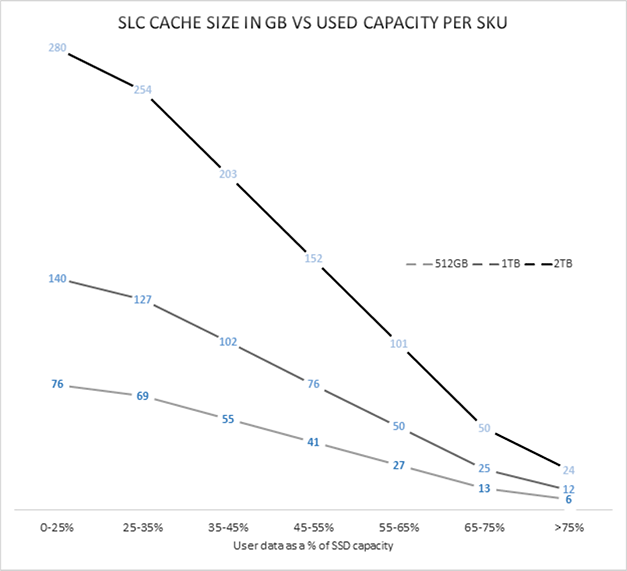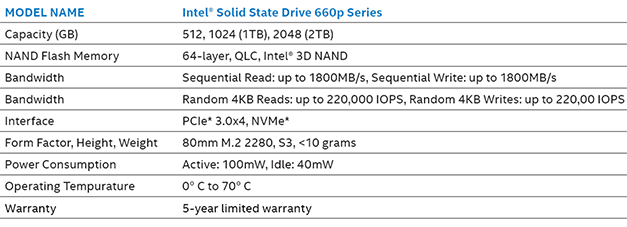Intel SSD 660p: Consumer NVMe Storage Just Got Significantly Cheaper
These drives are meant to finally put a nail in SATA’s coffin, thanks to their significantly better performance and aggressive pricing -- at under $0.20 per GiB in some configurations, believe it or not. Take a look at the Intel SSD 660p series’ main features and specifications below, then we’ll take a quick tour of the drive, and see how it performs...
|
The Intel SSD 660p will initially be offered in three capacities, 512GB, 1TB, and 2TB. We have a 1TB drive represented here and tested on the following pages.
All of the drives in the Intel SSD 660p series conform to the same M.2 (2280) 80mm ‘gumstick’ form factor, but performance varies depending on the capacity. The 512GB drive will put up sequential read speeds of roughly 1.74GB/s in CrystalDiskMark, with writes in the 968MB/s range, while the 1TB drive peaks at about 1.81GB/s reads, with much better 1.7GB/s writes. That kind of performance is far better than anything hanging off a SATA interface can muster, but it is not in the same league as more expensive NVMe PCIe-based drives, like Intel's own SSD 750 series or Samsung’s 970 EVO / PRO.
As we've mentioned, all of the drives in the series leverage brand-new 64-layer QLC 3D NAND flash memory (initially 1Tb per die), which is more economical than previous-gen TLC or MLC NAND. Paired to the NAND is a DRAM cache, and a native NVMe PCI Express controller built by Silicon Motion (SMI), with input from Intel. If you look closely, you can actually see an Intel logo silk-screened onto the chip. You'll notice there's not much happening on the back of the drive, but the front is home to the controller, the QLC NAND, and DRAM cache.
The controller natively supports NVMe and has a x4 PCIe 3.0 interface (max bandwidth of 4GB/s). These drives also support all of the things you’d expect from a modern SSD, like TRIM, garbage collection, S.M.A.R.T., etc., but it also supports AES-256 encryption and Pyrite 1.0 and 2.0.
Like many drives that use TLC NAND, Intel configures a portion of the QLC on these drives to act as an SLC cache for faster write throughput. Depending on the unused capacity of the drive, however, the size of the SLC cache will dynamically adjust up or down. Though there is a base amount that never changes, the overall amount of SLC available to accelerate writes changes based on the total and unused capacity of the drive -- this chart outlines where it falls on all three models.

Should the SLC cache be filled, write performance nosedives (you can see just how much on the HDTune benchmark page). However, doing so requires continually writing large amounts of data and shouldn’t happen very often, if at all.
Intel warranties the SSD 660p series drives for 5 years, which is on par with other NVMe PCIe solid state drives, and endurance is rated for 100 TBW per 512GB of capacity. That’s a little low versus many other drives, but should be plenty for any consumer workload. In terms of the packaging and bundle, everything included is pictured above. The drive comes in a simple box with cardboard reinforcement and a plastic shield, and that’s it. Support for the 660p series is coming to Intel's SSD Toolbox utility as well, which is available as a free download from Intel’s site.
Let's move on to setup and some benchmarking...







